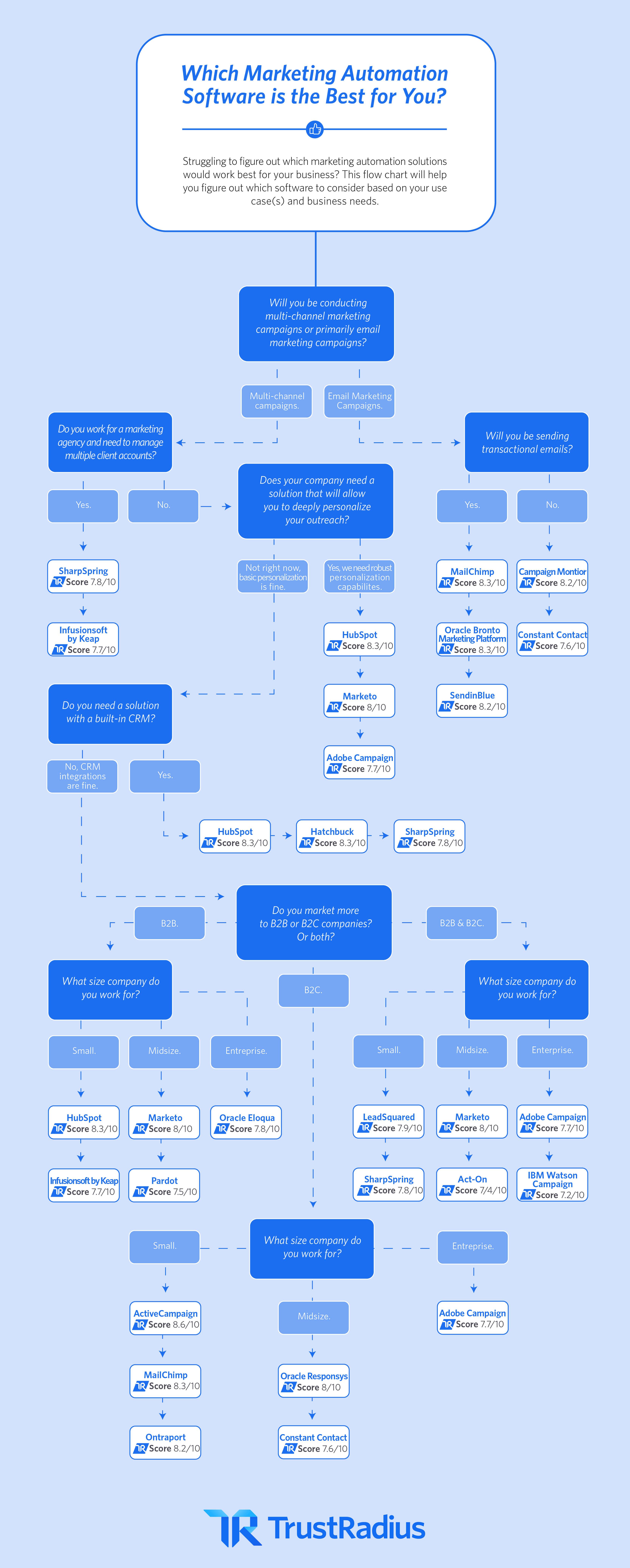How To Choose the Best Marketing Automation Software For Your Business
Marketing automation software can be called many things…a necessary evil, a means to an end, the thing that keeps you up at night because it accidentally unsubscribed your entire audience. Yet it’s still one of the few pieces of software that modern marketing teams truly can’t live without. It enables marketing teams to save an exponential amount of time by automating routine tasks and triggered workflows in addition to allowing them to track and evaluate the performance of marketing campaigns.
All kidding aside, marketing automation platforms can be difficult to figure out how to use at first, and often require a substantial amount of initial setup and configuration. Making sure that you’ve found the tool that matches your current business needs best can make this process easier, and help set you up for future success.
However, the sheer number of tools available on the market (131 are listed on TrustRadius alone!) can make this process seem incredibly daunting. Which products should you look at first? And how should you narrow down the huge field of products available?
This flowchart aims to help you answer these first few key questions about where to start your product search. The flowchart will walk you through a series of questions to help you get a better understanding of your specific use cases for the tool and provide a recommendation for which products to research further based on your answers. In total, there are 18 products listed on the flowchart—but no more than 2 or 3 are ever recommended as a solution to a specific question. Some examples of the types of questions asked include:
Will you primarily be conducting email marketing campaigns or multichannel campaigns?
Is your audience majority B2B, B2C, or both?
Do you work at a marketing agency and provide marketing services for multiple clients?
These questions can help you pinpoint the specific capabilities your marketing automation software should include, and figure out which products to put on your shortlist.
What is marketing automation software?
Before diving into the flowchart, here’s a quick primer on what exactly marketing automation software is, the main capability areas it includes, and key benefits of using the software.
The two overarching goals marketing automation software helps marketing teams achieve are 1) the ability to automate routine tasks and actions in a triggered workflow, and 2) the ability to track the success of their campaigns across email and other channels and gather insights about campaign performance over time. Traditionally, marketing campaigns were carried out mainly via email, sometimes including direct mail or phone calls as well. But nowadays there is a range of other digital channels, such as text/SMS and social media, that support campaigns as well. While email is still a mainstay for marketing campaigns, more and more companies are branching out and orchestrating campaigns across multiple channels.
Most marketing automation software will at least cover these 5 core capability areas:
1. Email and online marketing: this set of features enables marketers to build out emails and landing pages, and optimize their content format. It typically includes an email and landing page editor/builder, email personalization tools, email A/B testing, dynamic content features, mobile optimization, and the ability to set up triggered emails based on site visitor or audience behavior (e.g., clicking a link in an email or downloading content from your website).
2. Lead management: these features help evaluate the health of contacts in your database and identify which ones are ripe for the picking (so to speak). Features generally include lead scoring, lead nurturing, list segmentation (based on behavioral, demographic, and firmographic characteristics), and data quality management.
3. Campaign management: these features aim to help marketers keep track of campaigns and make sure they’re being executed properly. Capabilities generally include scheduling, ability to build out campaign sequences, and campaign performance monitoring.
4. Social media marketing: social media has become an increasingly important marketing arena, and these set of features help teams create content for launch campaigns across social platforms. Features typically include integrations with social profiles, the ability to create and schedule social media posts, social monitoring/listening, the ability to set up ‘share/like’ buttons, and social campaign performance analytics.
5. Reporting and analytics: these features correspond directly to the second overall goal of marketing teams—to evaluate campaign and landing page performance and improve it over time. Basic email (e.g., click-through rate, open rate) and landing page performance reports, ROI reporting on overall campaigns across channels, funnel reporting, SEO and keyword tracking, multi-touch revenue attribution, and web analytics are typically included.
Which tools will meet your needs best?
Now that we’ve outlined the basic profile for marketing automation software, it’s time to figure out which products should be on your shortlist.
The chart below asks a series of 7 questions to help you figure out which products are best suited for your specific circumstances and use cases.

Was this helpful?
